Design of a Millimeter-Wave Broadband Linearizer Based on an Extended Design Space
Abstract
1. Introduction
2. Theory and Analysis
2.1. Three-Segment Fitting of Gain Curves for a PA and Linearizer
2.2. Extension of the Definition of the 1 dB Compression Point
2.3. Design Space Extension for Broadband Linearizers
2.3.1. The Gain Expansion Turn-On Point Is Equal to
2.3.2. The Gain Expansion Turn-On Point Is Less than
2.3.3. The Gain Expansion Turn-On Point Is Greater than
3. Linearizer Design Based on the Extended Design Space
4. Measurements and Results
4.1. Measurement Platform
4.2. Continuous-Wave Test
4.3. Two-Tone Signal Test
5. Conclusions
Author Contributions
Funding
Data Availability Statement
Conflicts of Interest
References
- Xiao, M.; Mumtaz, S.; Huang, Y.; Dai, L.; Li, Y.; Matthaiou, M.; Karagiannidis, G.K.; Björnson, E.; Yang, K.; Chih-Lin, I.; et al. Millimeter wave communications for future mobile networks. IEEE J. Sel. Areas Commun. 2017, 35, 1909–1935. [Google Scholar] [CrossRef]
- Niu, Y.; Li, Y.; Jin, D.; Su, L.; Vasilakos, A.V. A survey of millimeter wave communications (mmWave) for 5G: Opportunities and challenges. Wirel. Netw. 2015, 21, 2657–2676. [Google Scholar] [CrossRef]
- Park, B.; Jin, S.; Jeong, D.; Kim, J.; Cho, Y.; Moon, K.; Kim, B. Highly linear mm-wave CMOS power amplifier. IEEE Trans. Microw. Theory Tech. 2016, 64, 4535–4544. [Google Scholar] [CrossRef]
- Yu, C.; Jing, J.; Shao, H.; Jiang, Z.H.; Yan, P.; Zhu, X.W.; Hong, W.; Zhu, A. Full-angle digital predistortion of 5G millimeter-wave massive MIMO transmitters. IEEE Trans. Microw. Theory Tech. 2019, 67, 2847–2860. [Google Scholar] [CrossRef]
- Haider, M.F.; You, F.; He, S.; Rahkonen, T.; Aikio, J.P. Predistortion-based linearization for 5G and beyond millimeter-wave transceiver systems: A comprehensive survey. IEEE Commun. Surv. Tutor. 2022, 24, 2029–2072. [Google Scholar] [CrossRef]
- Katz, A.; Wood, J.; Chokola, D. The Evolution of PA Linearization: From Classic Feedforward and Feedback Through Analog and Digital Predistortion. IEEE Microw. Mag. 2016, 17, 32–40. [Google Scholar] [CrossRef]
- Zhang, H.; Sanchez-Sinencio, E. Linearization Techniques for CMOS Low Noise Amplifiers: A Tutorial. IEEE Trans. Circuits Syst. 2011, 58, 22–36. [Google Scholar] [CrossRef]
- Peng, J.; You, F.; He, S. Under-sampling digital predistortion of power amplifier using multi-tone mixing feedback technique. IEEE Trans. Microw. Theory Tech. 2021, 70, 490–501. [Google Scholar] [CrossRef]
- Guan, L.; Zhu, A. Green communications: Digital predistortion for wideband RF power amplifiers. IEEE Microw. Mag. 2014, 15, 84–99. [Google Scholar] [CrossRef]
- Yu, C.; Guan, L.; Zhu, E.; Zhu, A. Band-limited Volterra series-based digital predistortion for wideband RF power amplifiers. IEEE Trans. Microw. Theory Tech. 2012, 60, 4198–4208. [Google Scholar] [CrossRef]
- Zhang, D.; Fu, W.; Deng, X.; Xu, X.; Zhang, B.; Yu, H.; Ma, K. X-to Q-Band MMIC Predistortion Linearizers with Tunable Frequency-Dependent Phase Conversion Capacity Using GaAs HEMT Technology. IEEE Trans. Microw. Theory Tech. 2022, 71, 1536–1549. [Google Scholar] [CrossRef]
- Xiao, Z.; You, F.; Hao, P.; Wang, Y.; He, Q.; Shen, C.; Li, C.; Ma, M.; Wu, J.; Fan, Y.; et al. A Ka-Band CMOS Power Amplifier with OP1dB Improvement Employing a Diode-Connected Analog Linearizer. IEEE Trans. Circuits Syst. Express Briefs 2023, 70, 2271–2275. [Google Scholar] [CrossRef]
- Deng, H.; Zhang, D.; Lv, D.; Zhou, D.; Zhang, Y. Analog Predistortion Linearizer with Independently Tunable Gain and Phase Conversions for Ka-band TWTA. IEEE Trans. Electron Devices 2019, 66, 1533–1539. [Google Scholar] [CrossRef]
- Yamauchi, K.; Mori, K.; Nakayama, M.; Mitsui, Y.; Takagi, T. A microwave miniaturized linearizer using a parallel diode with a bias feed resistance. IEEE Trans. Microw. Theory Tech. 1997, 45, 2431–2435. [Google Scholar] [CrossRef]
- Zhu, R.; Zhang, X.; Shen, D.; Zhang, Y. Ultra Broadband Predistortion Circuit for Radio-over-Fiber Transmission Systems. J. Lightw. Technol. 2016, 34, 5137–5145. [Google Scholar] [CrossRef]
- Rezaei, S.; Hashmi, M.S.; Dehlaghi, B.; Ghannouchi, F.M. A systematic methodology to design analog predistortion linearizer for dual inflection power amplifiers. In Proceedings of the 2011 IEEE MTT-S International Microwave Symposium, Baltimore, MD, USA, 5–10 June 2011; pp. 1–4. [Google Scholar] [CrossRef]
- Gumber, K.; Rawat, M. Low-Cost RFin–RFout Predistorter Linearizer for High-Power Amplifiers and Ultra-Wideband Signals. IEEE Trans. Instrum. Meas. 2018, 67, 2069–2081. [Google Scholar] [CrossRef]
- Gumber, K.; Rawat, M. Analogue predistortion lineariser control schemes for ultra-broadband signal transmission in 5G transmitters. IET Microwaves Antennas Propag. 2020, 14, 718–727. [Google Scholar] [CrossRef]
- Hao, P.; He, S.; You, F.; Shi, W.; Peng, J.; Li, C. Independently tunable linearizer based on characteristic self-compensation of amplitude and phase. IEEE Access 2019, 7, 131188–131200. [Google Scholar] [CrossRef]
- Tang, H.; He, S.; Hao, P.; Song, M.; Guo, J.; Xiao, Z.; Zhang, X.; Zeng, S.; Liu, Y.; Zhang, X.; et al. A Design Method for Reflective Analog Predistorter with Independently Tunable Gain. IEEE Microw. Wirel. Technol. Lett. 2024, 34, 338–341. [Google Scholar] [CrossRef]
- Song, M.; He, S.; You, F.; Zhang, X.; Zhong, C.; Yin, Y.; Xiao, Z.; Tang, H.; Guo, J.; Hao, P. An Analog Predistorter for Doherty Power Amplifiers Based On Minimum Gain and Phase Deviation. IEEE Trans. Circuits Syst. Express Briefs, 2024; early access. [Google Scholar]
- Kao, K.Y.; Hsu, Y.C.; Chen, K.W.; Lin, K.Y. Phase-Delay Cold-FET Pre-Distortion Linearizer for Millimeter-Wave CMOS Power Amplifiers. IEEE Trans. Microw. Theory Tech. 2013, 61, 4505–4519. [Google Scholar] [CrossRef]
- Cripps, S.C. RF Power Amplifiers for Wireless Communications; Artech house Norwood: Norwood, MA, USA, 2006; Volume 250. [Google Scholar]
- Belluot, J.; Rhun, G.L.; Augoyat, P.; Mouchon, G.; Maati, A.; Katz, A.; Gray, B.; Dorval, R. A 40 W Ka-Band RF Amplification Chain for Space Telecommunication SSPA Applications. In Proceedings of the 2019 49th European Microwave Conference (EuMC), Paris, France, 1–3 October 2019; pp. 404–407. [Google Scholar] [CrossRef]
- Yang, Y.; Chen, W.; Feng, Z. A Broadband Analog Predistortion Linearizer Based on Tunable Diodes for Ka Band Power Amplifier. In Proceedings of the 2020 International Conference on Microwave and Millimeter Wave Technology (ICMMT), Shanghai, China, 17–20 May 2020; pp. 1–3. [Google Scholar] [CrossRef]
- Hao, P.; He, S.; You, F.; Ge, J. Broadband linearizer based on equivalent power-dependent impedance function of diode and load match network. Microw. Opt. Technol. Lett. 2021, 63, 499–503. [Google Scholar] [CrossRef]
- Liu, T.; Su, X.; Wang, G.; Zhao, B.; Fu, R.; Zhu, D. A Broadband Analog Predistortion Linearizer Based on GaAs MMIC for Ka-Band TWTAs. Electronics 2023, 12, 1503. [Google Scholar] [CrossRef]
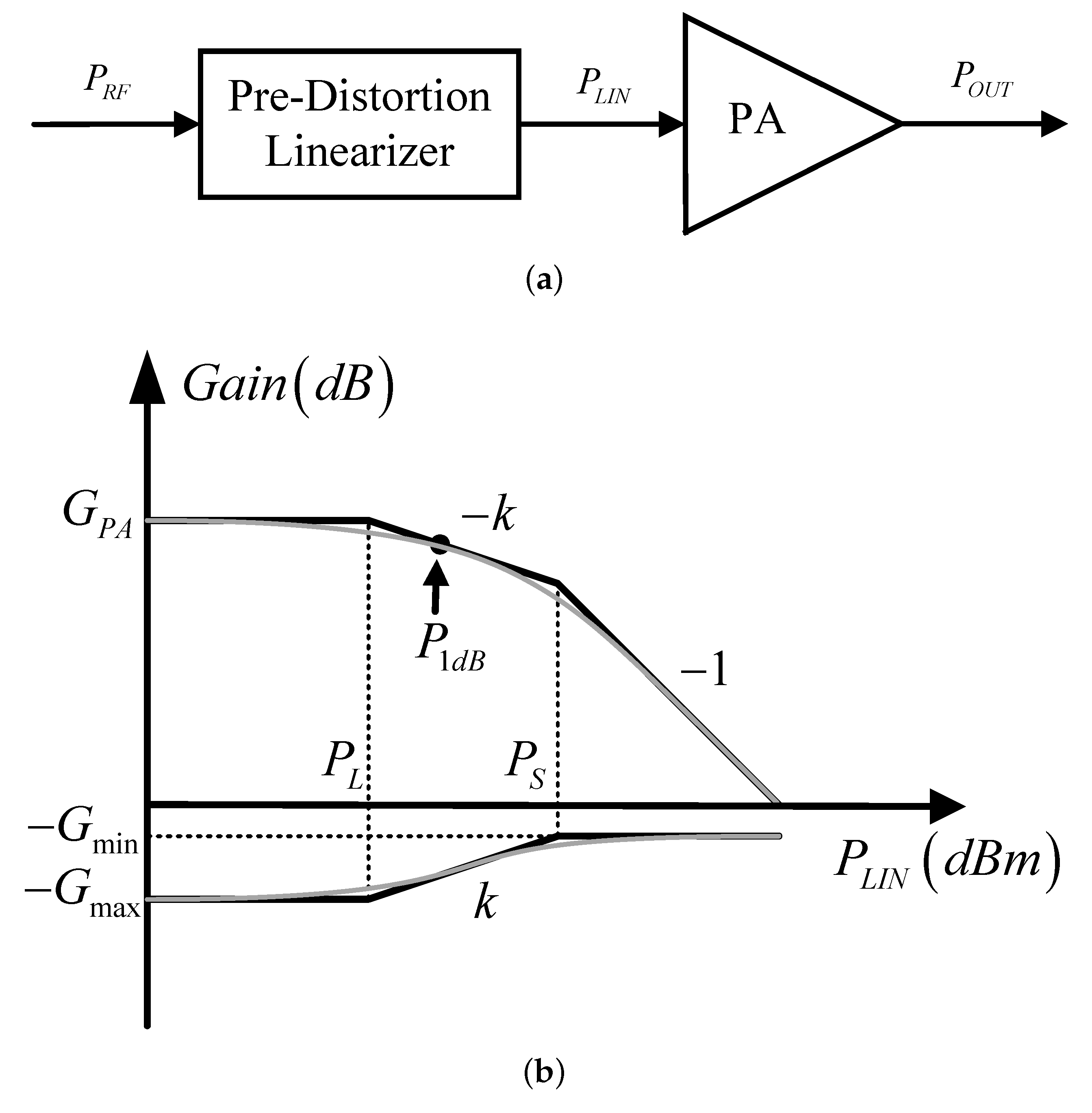
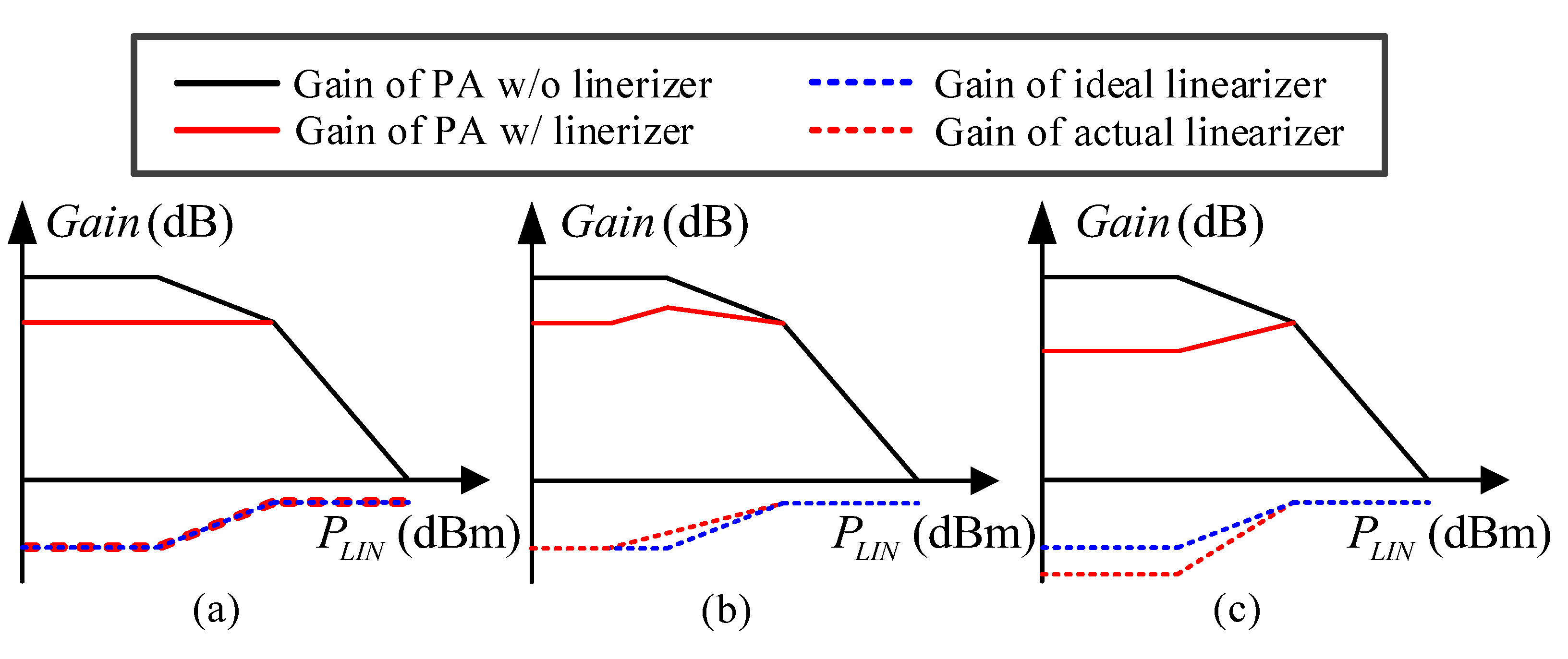
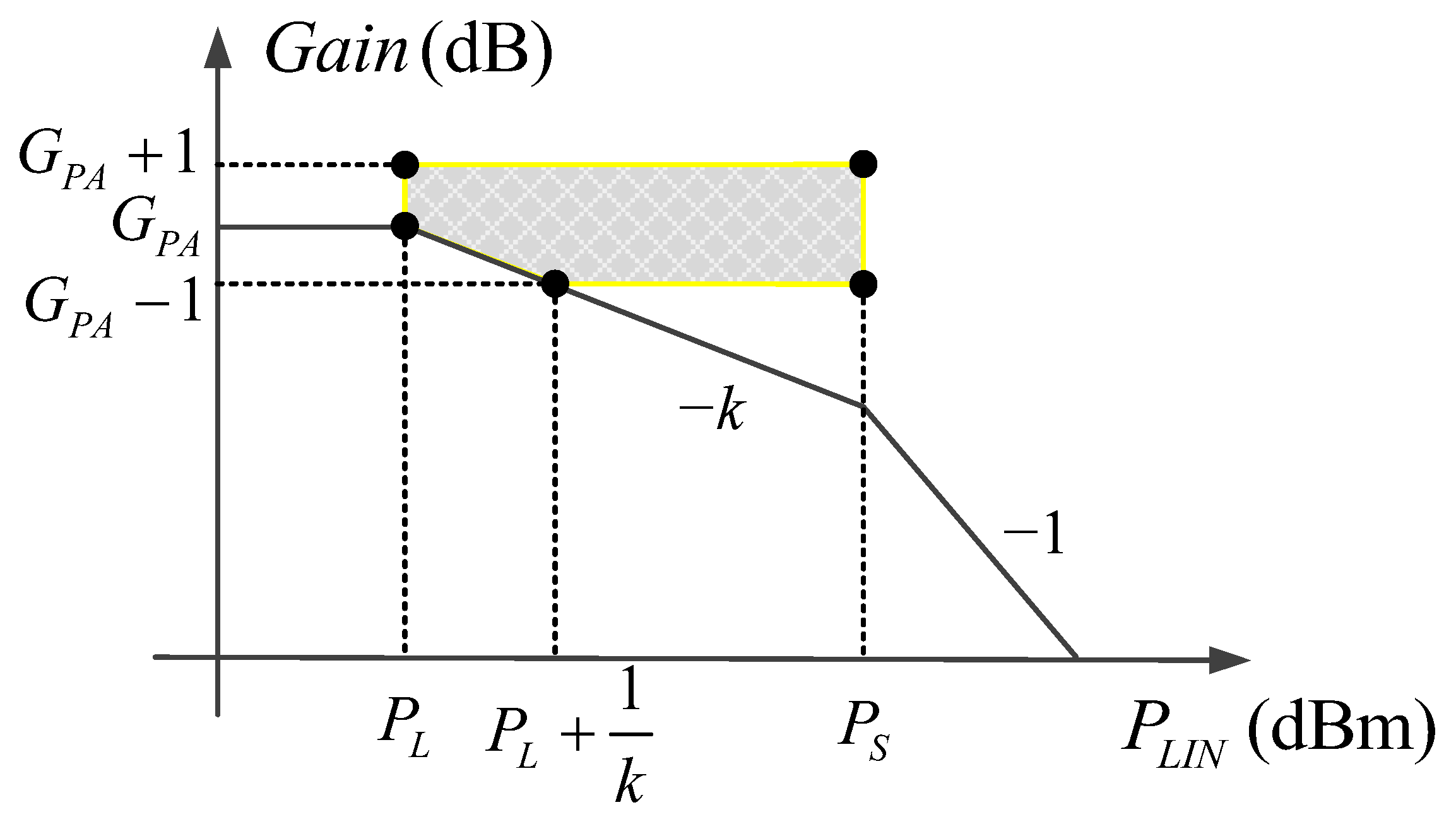
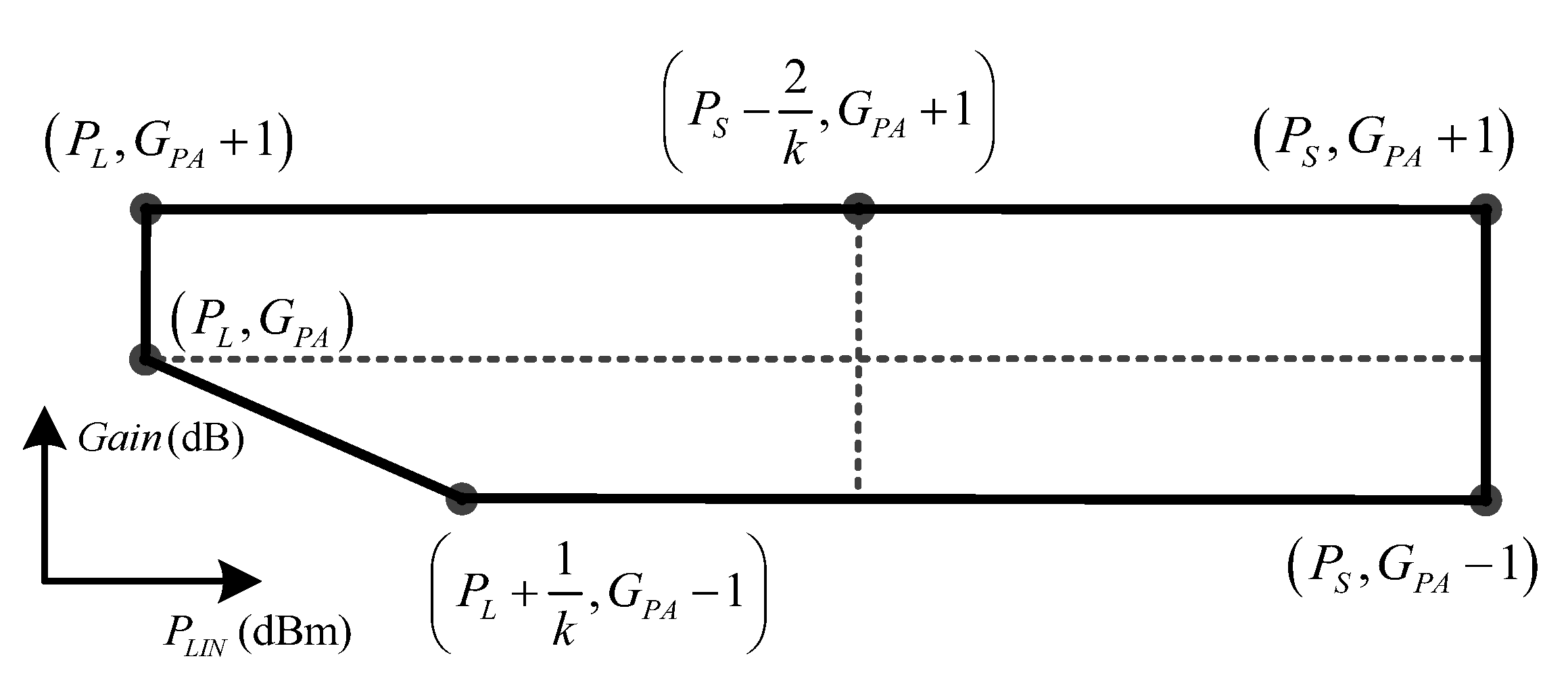


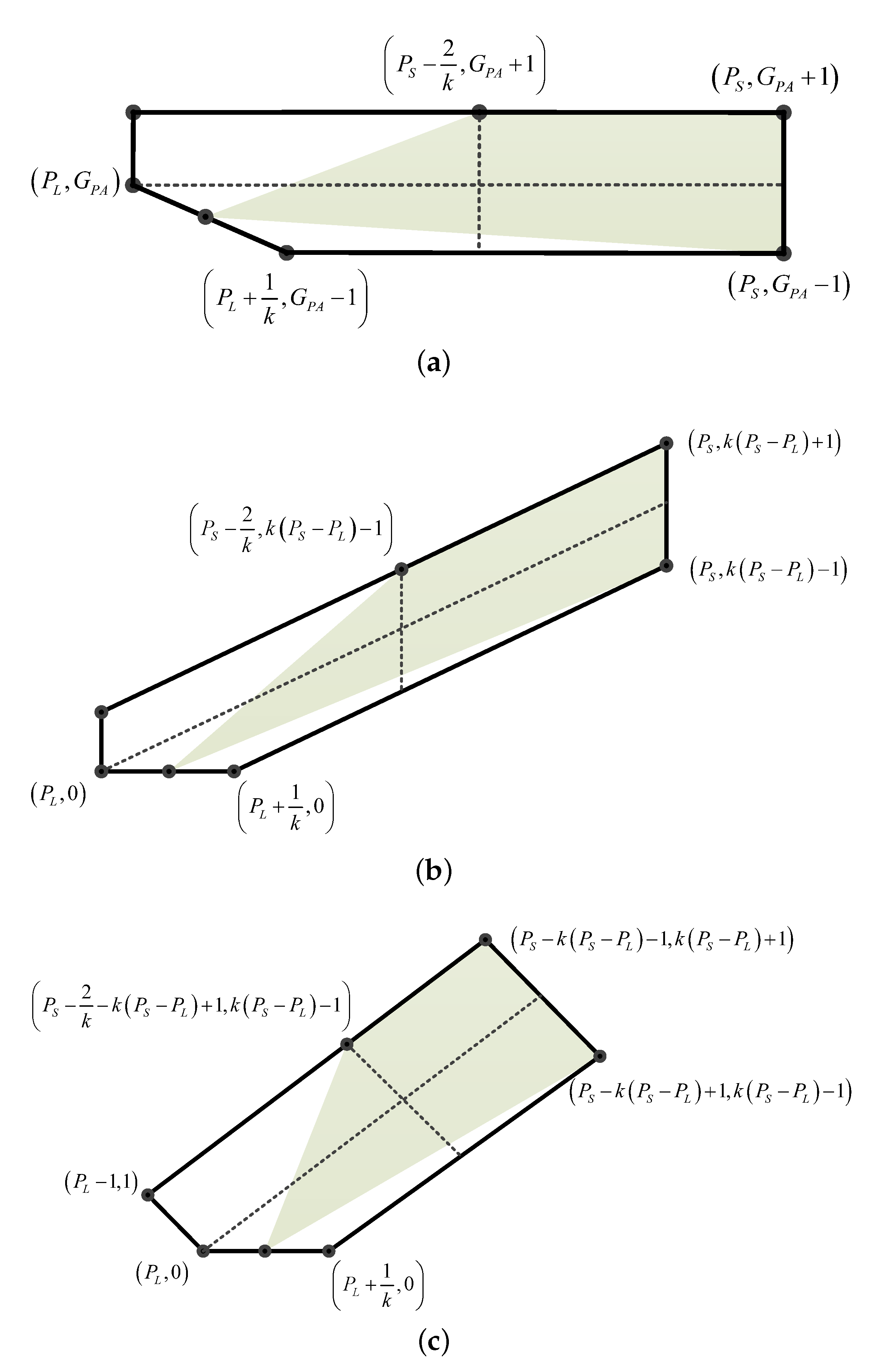
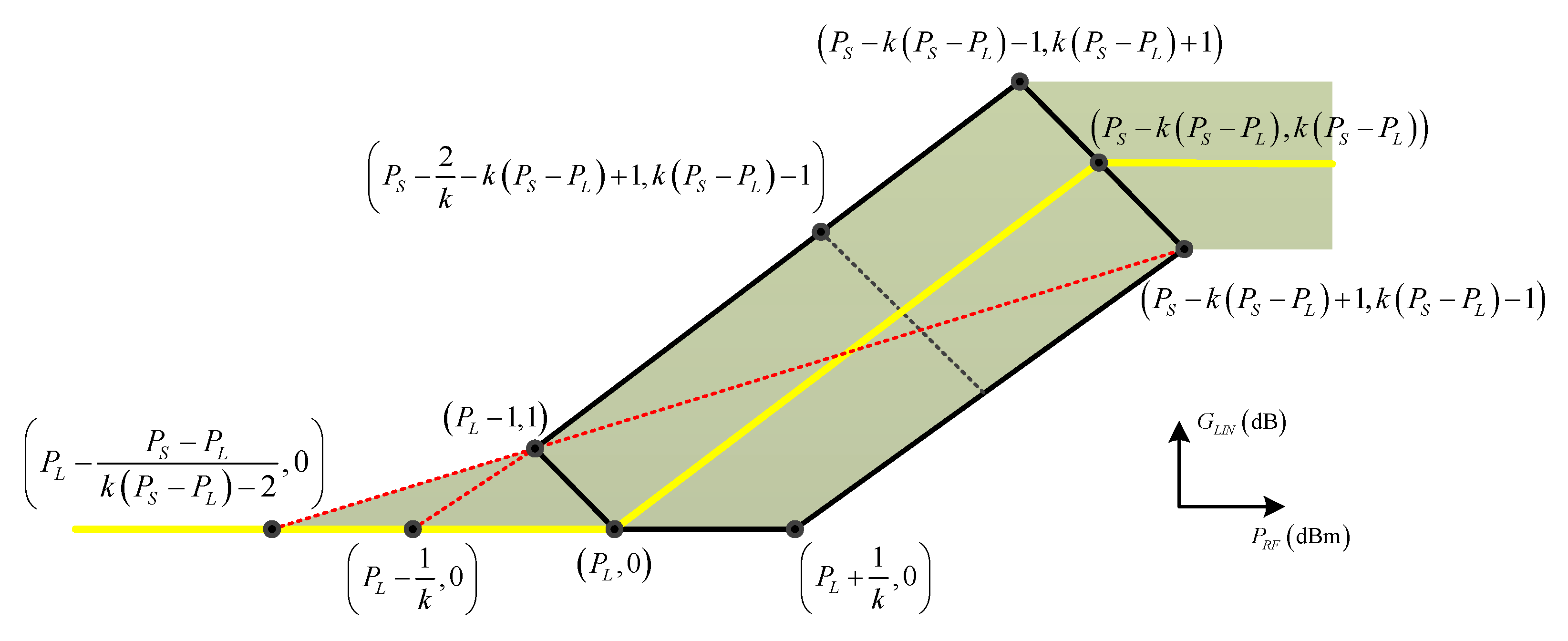
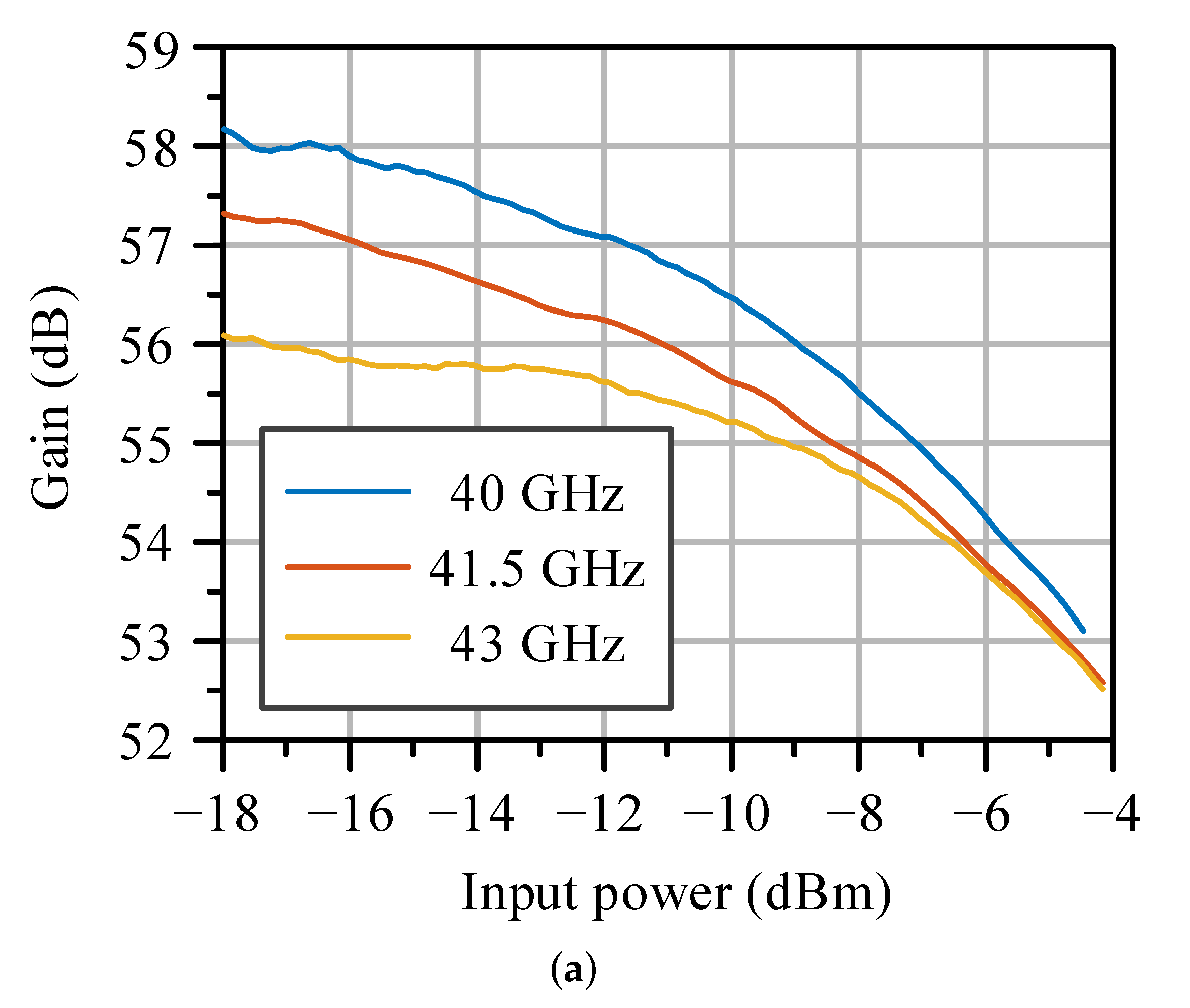

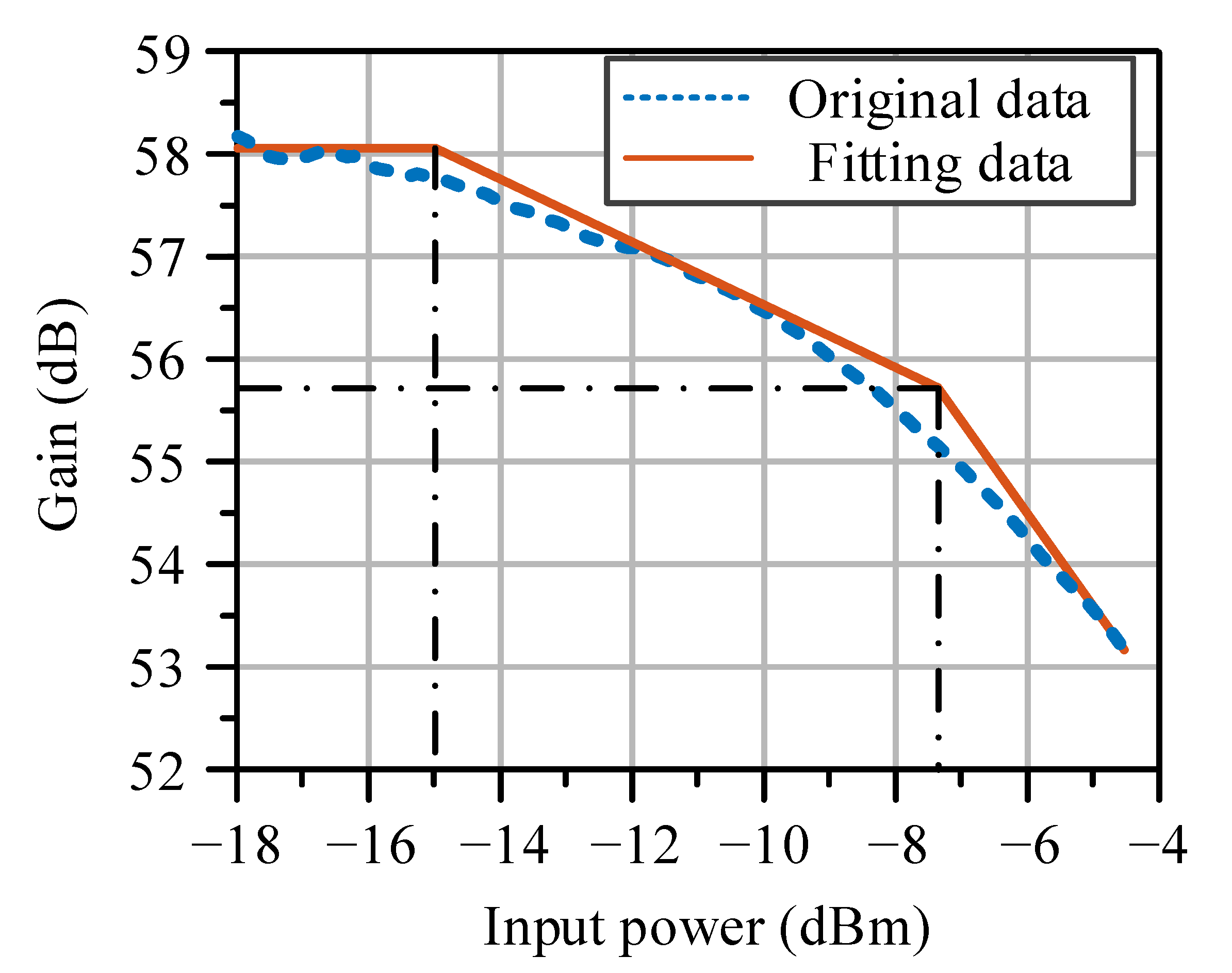
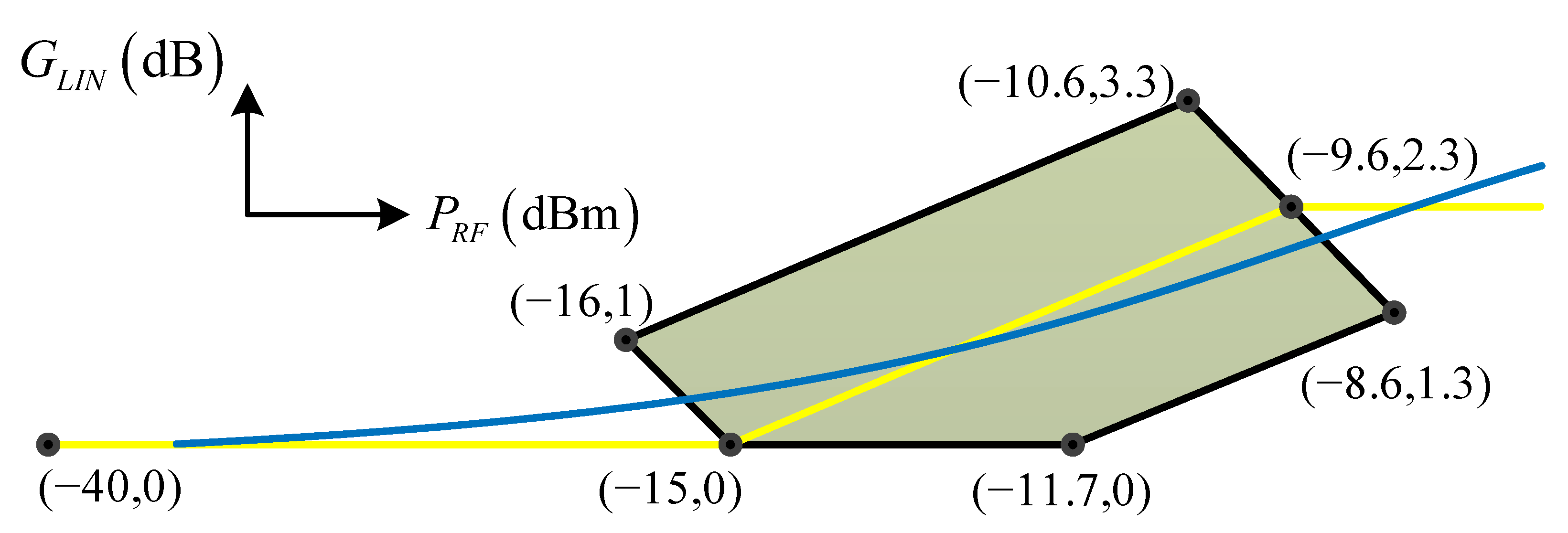
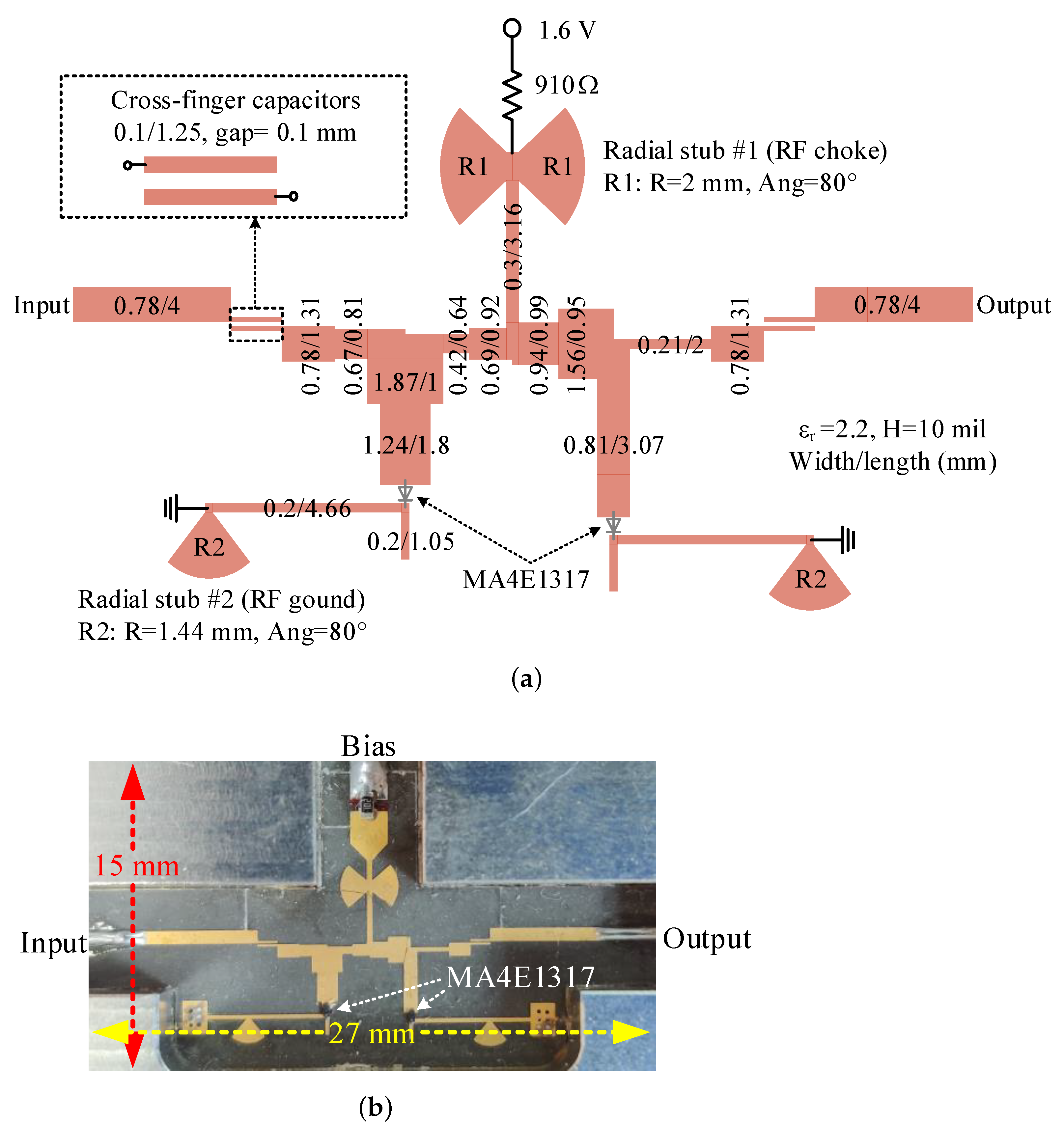
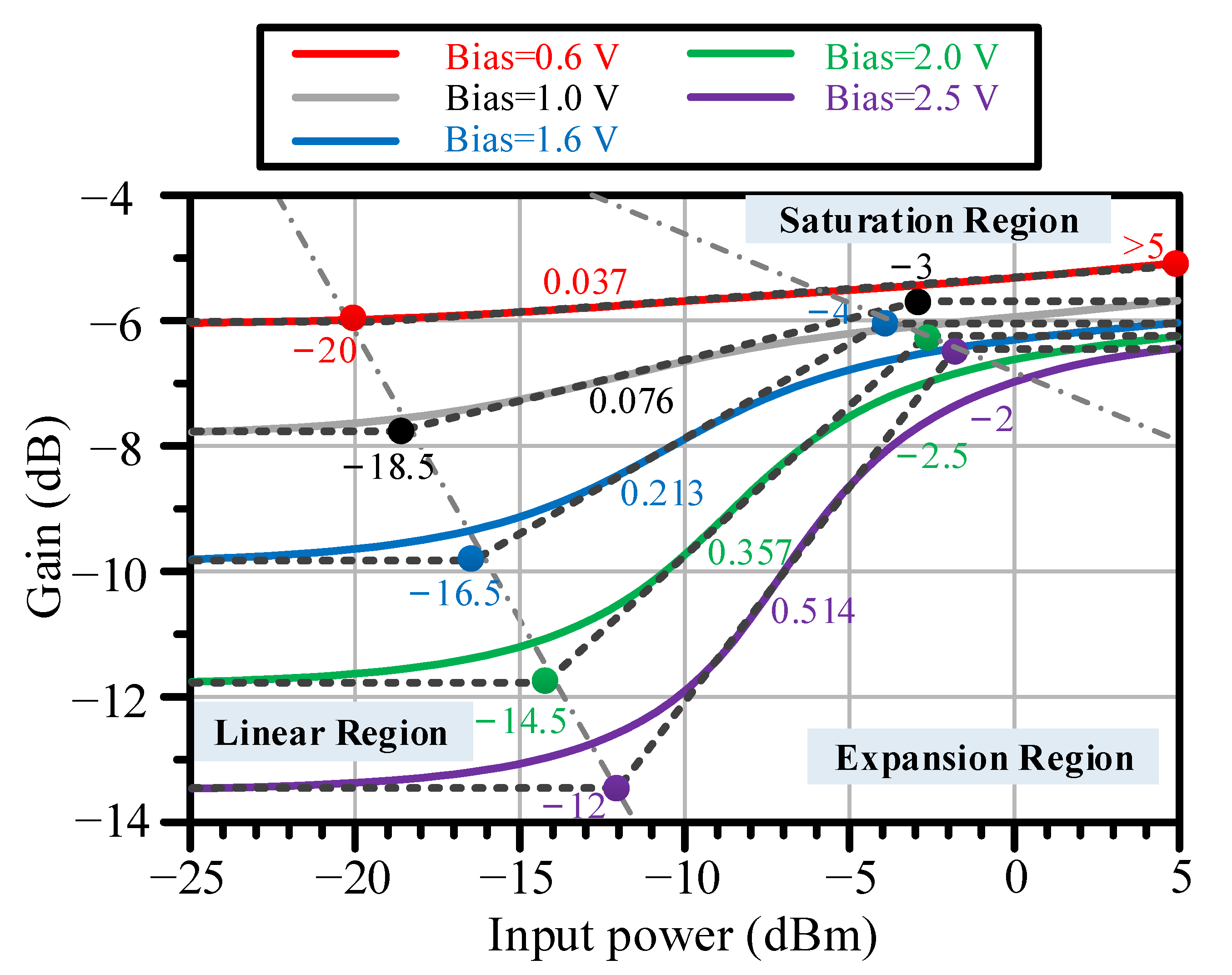

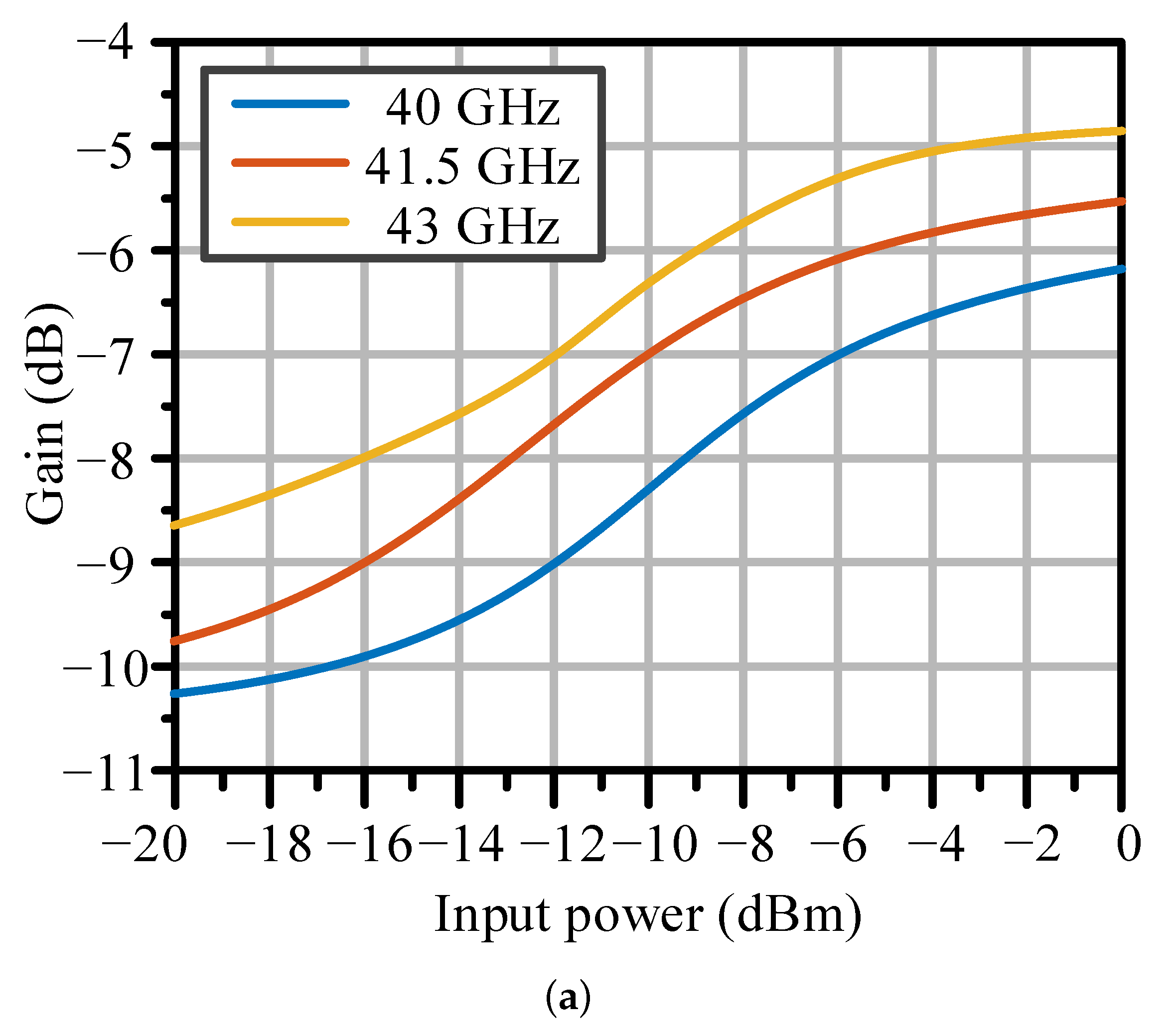

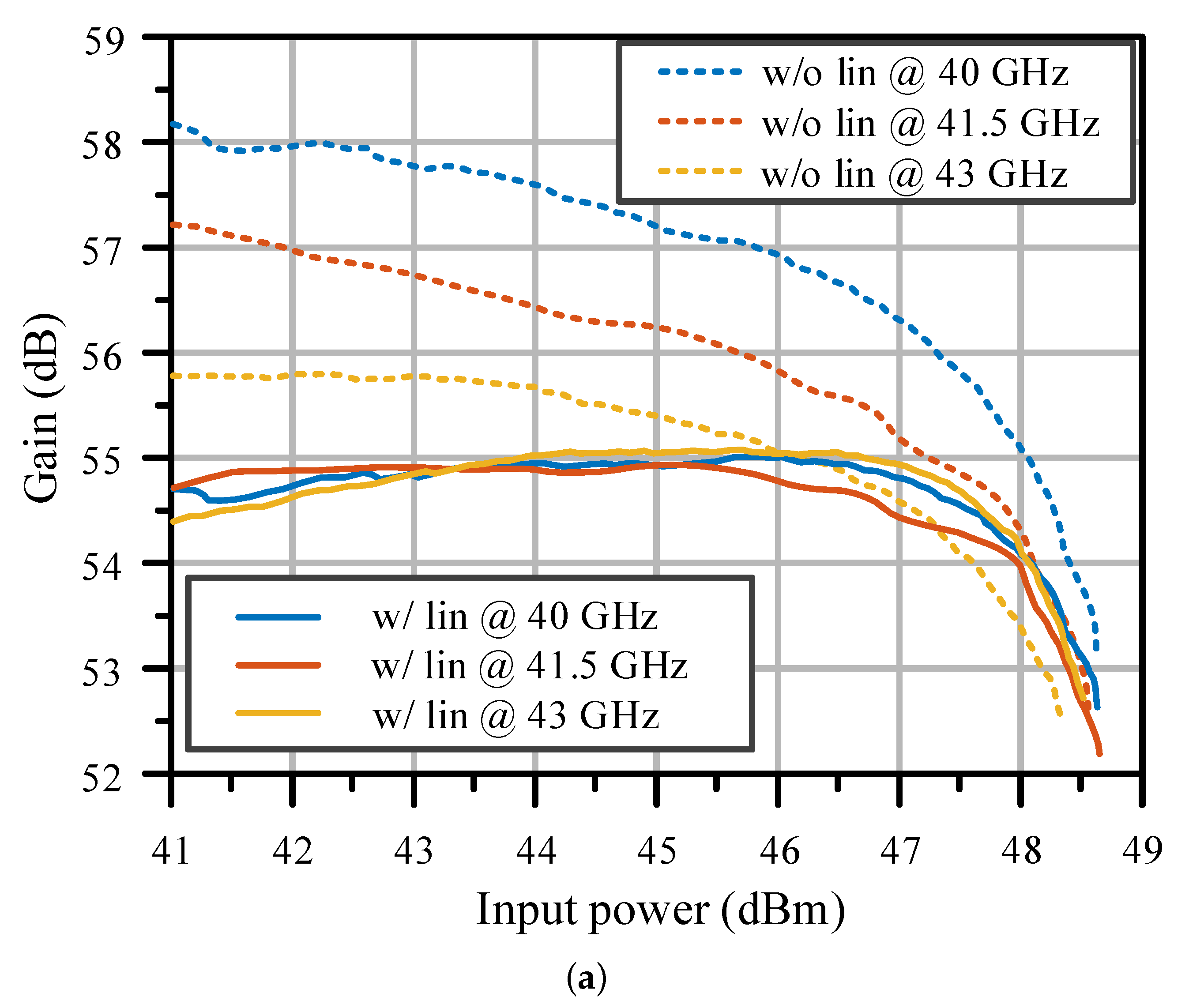
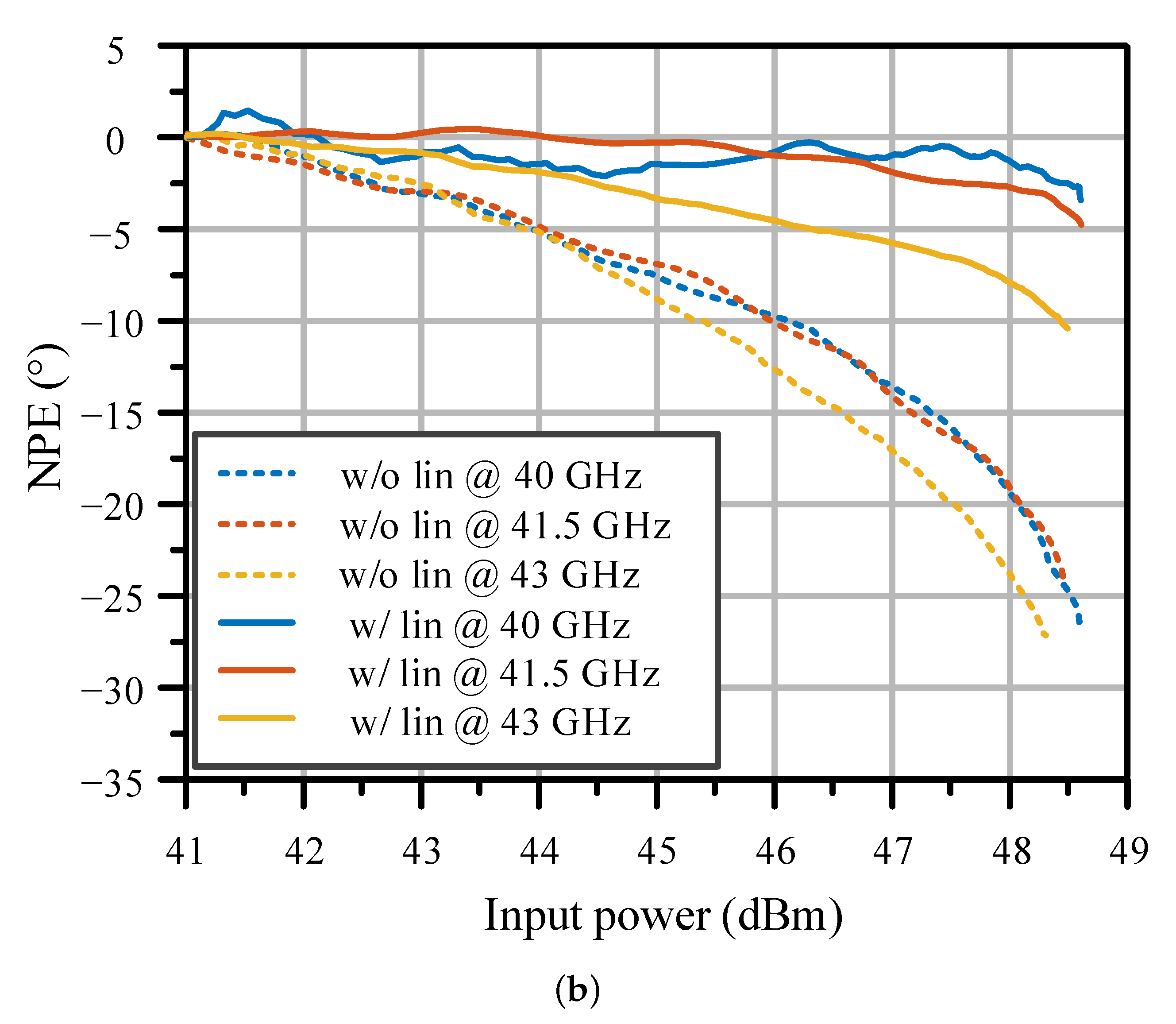
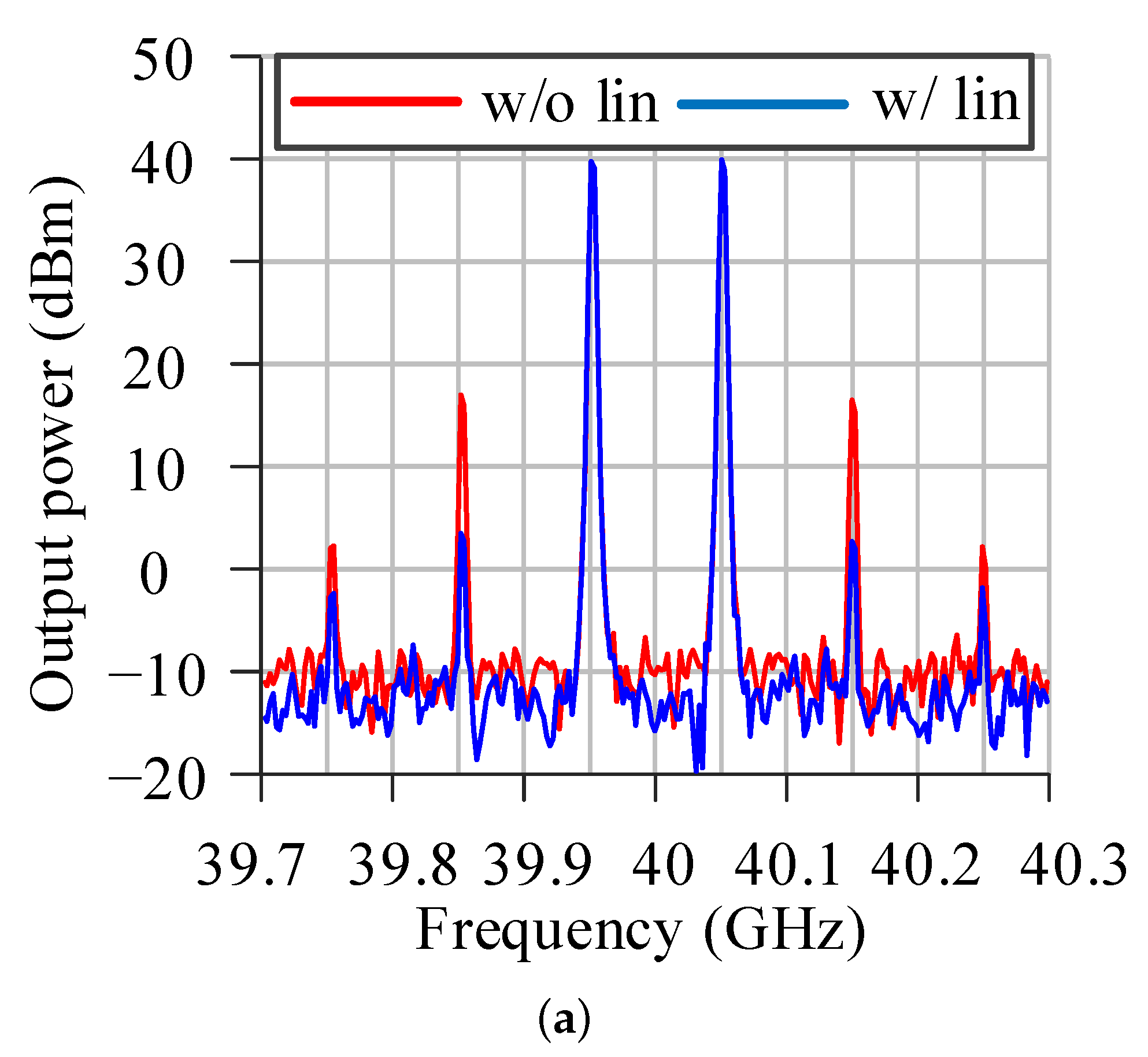
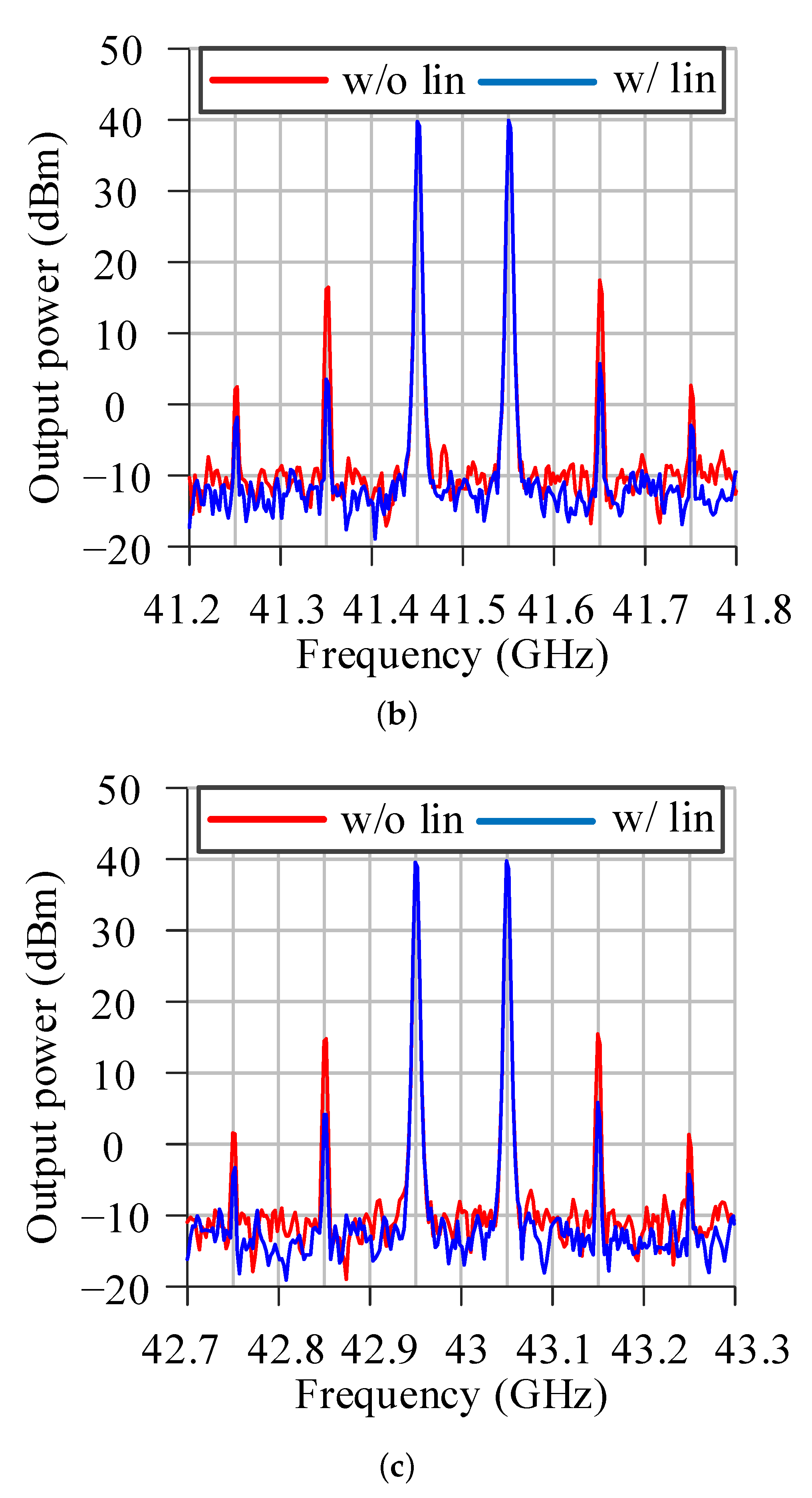
| Contents | Frequency | PA | Linearized PA |
|---|---|---|---|
| (dBm) | 40 GHz | 45.2 | 48.3 |
| 40.5 GHz | 45.1 | 48.1 | |
| 41 GHz | 46.6 | 48.3 | |
| NPE () | 40 GHz | 19.5 | 1.3 |
| 40.5 GHz | 19.4 | 2.8 | |
| 41 GHz | 23.6 | 7.9 | |
| IMD3 (dBc) § | 40 GHz | −23.1/−23.6 | −36.7/−37.5 |
| 40.5 GHz | −23.9/−22.6 | −36.6/−34.4 | |
| 41 GHz | −25.3/−24.3 | −35.6/−33.9 |
| Reference | Frequency | Two-Tone | IMD3 |
|---|---|---|---|
| Spacing | Suppression | ||
| 2019 [13] | 29–31 GHz | 20 MHz | 12.5–14 dB |
| 2019 [24] | 17.3–20.2 GHz | N/A | 15 dB |
| 2020 [25] | 27–31 GHz | 5 MHz | 11.5–22.6 dB |
| 2021 [26] | 29–31 GHz | 100 MHz | 12.2–14.6 dB |
| 2023 [27] | 25.1–27.5 GHz | 5 MHz | 9.5–14.5 dB |
| This Work | 40–43 GHz | 100 MHz | 8.6–13.1 dB |
Disclaimer/Publisher’s Note: The statements, opinions and data contained in all publications are solely those of the individual author(s) and contributor(s) and not of MDPI and/or the editor(s). MDPI and/or the editor(s) disclaim responsibility for any injury to people or property resulting from any ideas, methods, instructions or products referred to in the content. |
© 2024 by the authors. Licensee MDPI, Basel, Switzerland. This article is an open access article distributed under the terms and conditions of the Creative Commons Attribution (CC BY) license (https://creativecommons.org/licenses/by/4.0/).
Share and Cite
Hao, P.; Song, M.; Wang, P.; Shen, C. Design of a Millimeter-Wave Broadband Linearizer Based on an Extended Design Space. Electronics 2024, 13, 2000. https://doi.org/10.3390/electronics13112000
Hao P, Song M, Wang P, Shen C. Design of a Millimeter-Wave Broadband Linearizer Based on an Extended Design Space. Electronics. 2024; 13(11):2000. https://doi.org/10.3390/electronics13112000
Chicago/Turabian StyleHao, Peng, Minxian Song, Peng Wang, and Ce Shen. 2024. "Design of a Millimeter-Wave Broadband Linearizer Based on an Extended Design Space" Electronics 13, no. 11: 2000. https://doi.org/10.3390/electronics13112000
APA StyleHao, P., Song, M., Wang, P., & Shen, C. (2024). Design of a Millimeter-Wave Broadband Linearizer Based on an Extended Design Space. Electronics, 13(11), 2000. https://doi.org/10.3390/electronics13112000






